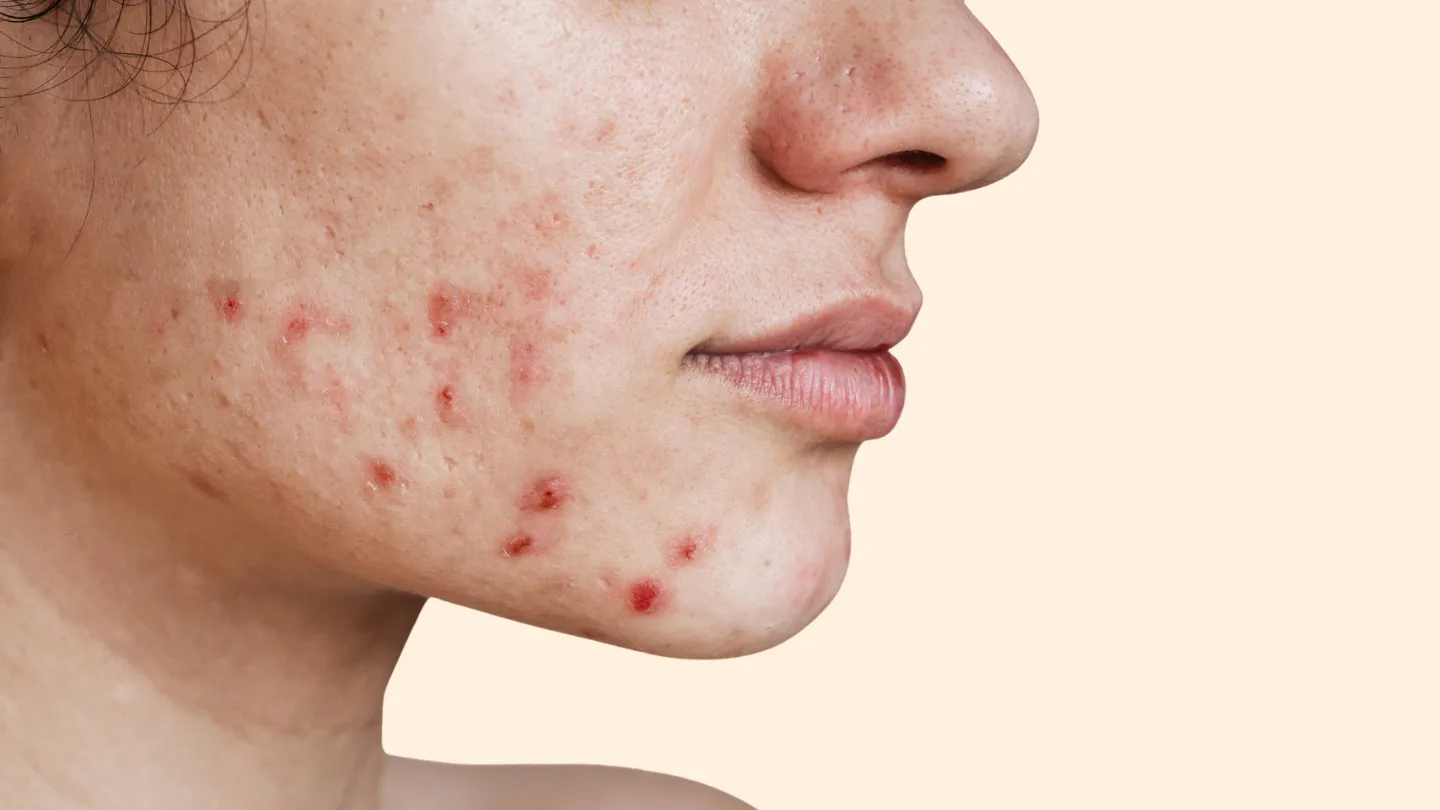Understanding Sebum and Its Role in Acne
Sebum, an oily substance produced by the sebaceous glands in our skin, plays a crucial role in maintaining the skin's natural protective barrier. It helps keep the skin supple, hydrated, and guarded against environmental aggressors. However, when sebum production goes into overdrive, it can lead to clogged pores and, ultimately, acne.
The Sebaceous Gland: A Sebum Factory
Sebaceous glands are tiny, sac-like structures found all over the body, but they are particularly concentrated in areas prone to acne, such as the face, chest, and back. These glands are connected to hair follicles and secrete sebum, which travels through the follicle and reaches the skin's surface.
The Sebum Plug: A Breeding Ground for Trouble
Sometimes, sebum, along with dead skin cells and other debris, can accumulate within the hair follicle, forming a plug. This sebum plug acts as a barrier, preventing the natural flow of sebum to the skin's surface. When this plug is exposed to air, it creates the perfect environment for a type of bacteria called Propionibacterium acnes (P. acnes) to thrive.
The Role of Propionibacterium Acnes in Acne Formation
P. acnes is a common inhabitant of our skin, living primarily within the hair follicles. While it's generally harmless in small quantities, when the sebum plug is exposed to air, P. acnes can multiply rapidly, leading to an inflammatory response and the formation of acne lesions.
Inflammation and Acne: A Vicious Cycle
As P. acnes proliferates, it releases enzymes that break down sebum into fatty acids. These fatty acids, combined with the bacteria's byproducts, trigger an inflammatory response in the surrounding skin tissue. This inflammation causes redness, swelling, and the formation of various types of acne lesions, such as whiteheads, blackheads, papules, pustules, and nodules.
The Varying Appearance of Acne Lesions
The appearance of acne lesions can vary depending on the degree of inflammation and the depth at which the sebum plug is located. Whiteheads and blackheads, for example, are relatively mild forms of acne that occur when the sebum plug is near the skin's surface. Papules and pustules, on the other hand, are more inflamed and often signify a deeper sebum plug within the follicle. Nodules and cysts, the most severe forms of acne, occur when the inflammation and infection reach deeper layers of the skin.
Factors Influencing Sebum Production and Acne
While the exposure of the sebum plug to air is a crucial factor in acne formation, it's not the only contributor. Several other factors can influence sebum production and the overall development of acne.
Hormonal Fluctuations and Acne
Hormones, particularly androgens, play a significant role in regulating sebum production. During puberty, increased androgen levels can stimulate the sebaceous glands, leading to an overproduction of sebum and an increased risk of acne. Hormonal changes during menstruation, pregnancy, and certain medical conditions can also contribute to acne breakouts.
Genetics and Acne Susceptibility
Our genes can influence our skin's sebum production and sensitivity to acne-causing factors. If one or both parents had severe acne during their lives, their offspring may be more prone to developing acne as well. Genetic factors can also affect the skin's inflammatory response and the composition of sebum, further influencing acne susceptibility.
Lifestyle and Environmental Factors
Certain lifestyle and environmental factors can also impact the development of acne. Poor hygiene, stress, diet, and the use of specific cosmetics or skincare products can all contribute to clogged pores and acne flare-ups. Additionally, environmental factors like humidity, pollution, and exposure to certain chemicals can exacerbate acne in some individuals.
Treating Acne: A Multifaceted Approach
Given the complex nature of acne, effective treatment often requires a multifaceted approach that addresses the various underlying factors.
Topical Treatments and Medications
Topical treatments and medications are commonly used to help manage acne. These can include over-the-counter or prescription-strength products containing ingredients like retinoids, benzoyl peroxide, salicylic acid, or antibiotics. These treatments work by unclogging pores, reducing inflammation, and controlling the growth of P. acnes bacteria.
Oral Medications and Hormonal Therapy
For more severe or persistent acne, oral medications may be prescribed. These can include antibiotics, isotretinoin (a potent form of vitamin A), and hormonal therapies for women. Hormonal therapies, such as birth control pills or spironolactone, can help regulate sebum production and reduce acne-related inflammation.
Lifestyle Modifications and Support
Lifestyle changes can also play a supportive role in managing acne. Adopting a healthy, balanced diet, managing stress levels, practicing good skincare routines, and using non-comedogenic (non-pore-clogging) cosmetics can all contribute to improved skin health and reduced acne severity.
Conclusion
Acne is a complex condition that involves various factors, including the exposure of the sebum plug to air. When this sebum plug comes into contact with air, it creates an environment that allows P. acnes bacteria to thrive, triggering an inflammatory response and the formation of acne lesions. By understanding the underlying mechanisms and contributing factors, individuals can work with dermatologists and healthcare professionals to develop comprehensive treatment plans tailored to their specific needs. With persistence and the right approach, acne can be managed effectively, leading to clearer, healthier skin.
FAQs
What is a sebum plug and how does it contribute to acne?
A sebum plug is an accumulation of sebum (oil), dead skin cells, and other debris that clogs the hair follicle. When this plug becomes exposed to air, it creates an environment that allows the Propionibacterium acnes bacteria to multiply, leading to inflammation and acne lesions.
Can stress cause acne?
Yes, stress can contribute to acne flare-ups. When the body is under stress, it produces higher levels of hormones like cortisol, which can stimulate the sebaceous glands to produce more sebum. Additionally, stress can weaken the immune system, making it harder for the body to fight off acne-causing bacteria.
Is acne hereditary?
Genetics can play a role in an individual's susceptibility to acne. If one or both parents had severe acne during their lives, their offspring may be more prone to developing acne as well. Genetic factors can influence sebum production, inflammatory responses, and the composition of sebum, all of which can contribute to acne formation.
Can diet affect acne?
There is some evidence that certain dietary factors may influence acne. While research is ongoing, a diet high in processed foods, refined carbohydrates, and dairy products has been linked to increased acne severity in some individuals. Adopting a balanced, nutrient-rich diet can support overall skin health and potentially help manage acne.
How can I prevent acne?
While acne cannot be entirely prevented, there are several steps you can take to help manage it:
- Practice good skincare routines, including regular cleansing and the use of non-comedogenic (non-pore-clogging) products.
- Manage stress levels through exercise, relaxation techniques, and other healthy coping mechanisms.
- Adopt a balanced diet rich in antioxidants, vitamins, and minerals.
- Avoid picking or squeezing acne lesions, as this can lead to further inflammation and scarring.
- Consult a dermatologist for professional guidance on effective treatments and medications tailored to your specific needs.
Disclaimer: This article is for informational purposes only and does not constitute medical advice. Always consult with a healthcare professional before starting any new treatment regimen.
Related Coverage
Retinoids, antibiotics, hormonal therapies and more - learn how the top prescription acne medications like Retin-A, Differin and Epiduo Forte help treat teenage breakouts....
Does fasting cause acne breakouts? Intermittent fasting may impact hormones and lead to more pimples. Get tips to prevent acne flares during fasting....
Some report acne breakouts when taking ashwagandha supplements. Learn the theories behind ashwagandha causing acne and proactive steps to reduce skin irritation....
Explore the anatomy of the double bum crease, causes of an exaggerated crease, and treatments like exercise, weight management, and posture improvement to reduce its appearance....
Discover the most effective acne body washes for treating and preventing pimples on your chest, back, and shoulders. Discusses ingredients that clear body acne....
If your acne is painfully itchy, inflammation and bacteria trapped in clogged pores may be to blame. Discover ways to treat irritation and prevent future breakouts....
Keratosis pilaris bumps may be tempting to pop but can lead to scarring, infection, and more inflammation. Here's how to safely treat KP bumps....
Learn how to accurately and sensitively depict the physical, emotional, and psychological symptoms of depression in writing to increase awareness and understanding....
Learn about the causes of fungal acne, the importance of using a specialized fungal acne face wash, and tips for effectively treating and preventing stubborn fungal breakouts....
Sulfur offers remarkable benefits for acne, including oil absorption, antimicrobial properties, and exfoliation. Discover its advantages for clear skin....






